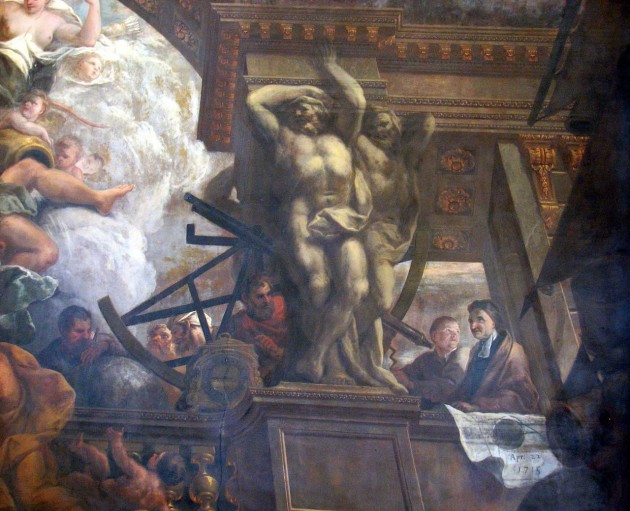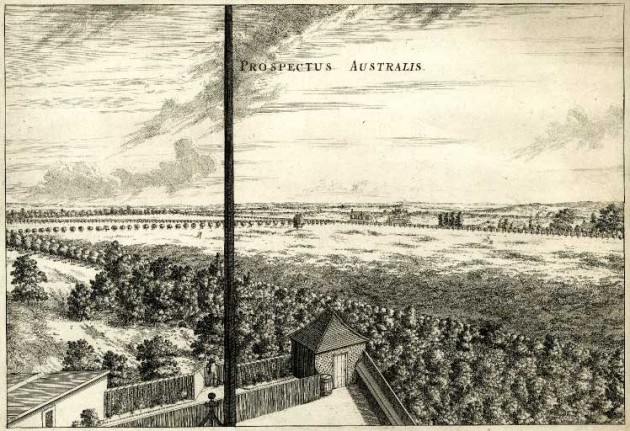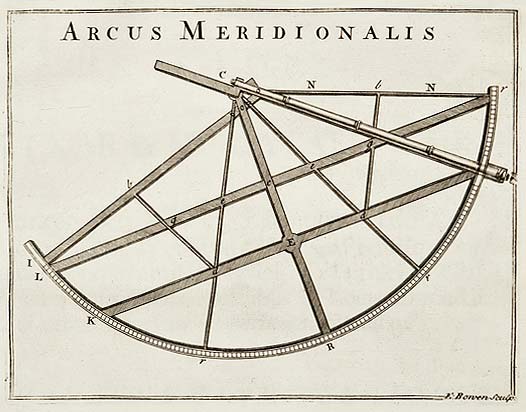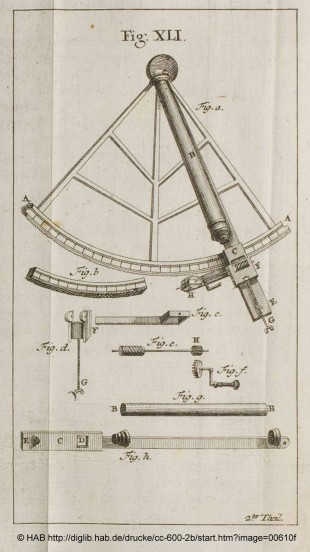…where east meets west
- Home
- Brief History
- The Greenwich Meridian
- Greenwich
(1675–1958) - Herstmonceux
(1948–1990) - Cambridge
(1990–1998) - Outstations (1822–1971)…
- – Chingford (1822–1924)
- – Deal
(1864–1927) - – Abinger
(1923–1957) - – Bristol & Bradford on Avon
(1939–1948) - – Bath
(1939–1949) - – Hartland
(1955–1967) - – Cape of Good Hope
(1959–1971)
- Administration…
- – Funding
- – Governance
- – Inventories
- – Pay
- – Regulations
- – Royal Warrants
- Contemporary Accounts
- People
- Publications
- Science
- Technology
- Telescopes
- Chronometers
- Clocks & Time
- Board of Longitude
- Libraries & Archives
- Visit
- Search
Telescope: Flamsteed’s Mural Arc (1689)
The Mural Arc was designed by Flamsteed to enable him to measure star positions more accurately than he was able to do with his Equatorial Sextant. It was a replacement for the unsatisfactory ‘Slight’ Mural Arc of 1683, which itself was a replacement for the unworkable 10-foot Mural Quadrant that Hooke that had supplied to the Observatory in 1676.
Mounted on a wall in the plane of the Meridian, it consisted of a graduated arc fitted with a telescopic sight. Used in conjunction with an accurate pendulum clock, it allowed Flamsteed to measure the zenith distance of a heavenly body as it crossed the Meridian as well as the mean solar time at which this happened. From this he was able to calculate the objects right ascension and declination.

Flamsteed (right) with Thomas Weston at the eye-piece of the Mural Arc. The horizontal limb beneath the telescope tube carries the inscription 'Sharp fecit'. Detail from the ceiling of the Painted Hall in the Old Royal Naval College, Greenwich by Sir James Thornhill. Commissioned in 1707 the painting of the ceiling was completed in 1712
The Mural Arc was the most important of all Flamsteed’s observing instruments. Paid for by Flamsteed personally, its construction began in 1688 after he came into money following the death of his father. The first recorded observation was made on 11 September 1689 and the last on 27 December 1719. In total, over 28,000 observations were made with the instrument. They were published in Volume 2 of Historia Coelestis Britannica in 1725, and providing much of the data needed for the catalogue of 2935 stars which was published in volume 3.
The instrument was removed in 1720 by Flamsteed’s wife Margaret following his death at the end of 1719. Apparently still in existence in 1721, it then disappeared from the records.
The instrument’s location at Greenwich
Although there is no specific record as to where the instrument was mounted, it has come to be accepted that it was erected on the west wall of the Quadrant House, opposite the wall on which Hooke’s 10-foot Mural Quadrant had previously been mounted. Airy was of the mistaken view that it had been mounted on the west wall of the sextant house (the back of the east wall of the Quadrant House to which Hooke’s 10-foot Mural Quadrant had been attached). Evidence that it was the former, comes from an unsent letter from Flamsteed to Newton, dated 20 February 1691/2:
‘Some that see it and are desirous to show their witt in findeing falts with what they understand not will hint the wall to which tis fastened is too weake. I find no such thing. the other that was 3 foot thick was not drie in the Middle tho It has stood above 16 yeares. this is but 2½ brick. and I doubt not is, and has sunke all it is likely it can I am sure I find no alterations in this Instrument since I began to use it first in Sept. 89 but what proceeded from the other causes and if the Wall should any ways sinke never so little it would Imediately and easily be perceived.’
Over the succeeding years, the wall did in fact suffer from subsidence, caused in part by its location close to the edge of a hill and in part by its shoddy construction. Flamsteed was able to calculate the rate at which it was subsiding from his observations of the stars and correct their observed positions accordingly.
So why did Flamsteed mount the Mural Arc on the east side of the western wall of the Quadrant House when he could have hung it on the back of the more substantial east wall next to his sextant as Airy surmised? Alternatively, why didn’t he design the instrument as a mirror image of itself? This would have enabled him to mount it on the more substantial east wall of the Quadrant House. Unfortunately, we do not know the answers.

Looking south from the Octagon Room c.1676. The west wall of the Quadrant House, is visible on the left. By the time the Mural Arc was mounted, the window would have been bricked up. Engraved by Francis Place after Robert Thacker. © Trustees of the British Museum
Flamsteed’s description of the instrument
Volume 3 of Historia Coelestis carries a description of the instrument in latin. The accompanying plate (below) is incomplete and has been known to appear in both Volume 1 and Volume 3. Click here to see it as bound into volume 1.
An English translation was published by William Cudworth in his volume: Life and correspondence of Abraham Sharp, in 1889. It is transcribed below.
The making of this [instrument] was principally the work of Abraham Sharp, my most trusty assistant, a man enriched with gifts and resources of every kind to render him competent to complete a work so intricate and difficult. This instrument cost me fourteen months' work and over £120 in money. I will here give some account of it, and will afterwards show how my Catalogue of Fixed Stars was obtained from observations carried on by me through nearly thirty years, by means of this instrument after it had been completed.

Flamsteed's Mural Arc. From Volume 3 of Historia Coelestis Britannica, (London, 1725)
The radius from the centre of the arc to the edge of the spiral is 79½ inches, and along the rods or radii is supported by iron bands above and below, of which the upper band C L and the middle one C R are thicker, and the others more slender. At right angles with the middle band C R is another iron band E K, and on the lower side, under E, where they are joined together, is placed a large iron nail which is driven into a firm piece of oak which is fixed to the wall, and so strengthens the arc, and the other ribs joining to and supporting it at the points marked d d. Another heavy iron rib, r I, parallel to this is placed on the fulcrum, which is connected with the three middle radii in the points c c c, which, together with the lower face of the limb, near the points i and r, and where the 2nd and 4th radii pass through the greatest iron band, namely, at the points d and d, two other supporting beams d b and d b are raised as far as the two extreme radii at b and b, and as far as the upper transverse beam. All the radii e r, C R, c r, r r, are fixed to the upper solid beam i m, under the centre C, at o o o o, and the whole instrument hangs from and is sustained by two thick iron supports under the upper beam at N and N, above the wall.
To the meridian wall (to which it is affixed) various pieces of wood are fixed which keep the arc removed from it, and by means of iron and of wooden wedges, keep the arc stable and always at the same distance from the wall, so that it is unable to swerve unless the wall subsides or bends from the perpendicular.
The index of the arc is formed like that of a sextant, but is much heavier, and for the relief of the hand which raises or depresses it, is fastened to a cord, which, by means of a screw and of a balance-weight, removes a great part of the weight, and renders it easy to be moved by a careful man. This index is fitted with telescopes of convex glasses, and with a pair of cross threads like the index of a sextant, and is carried round the limb by means of a screw attached to it, which is carried round in the same manner as the index itself and needs no further description.
Now in order to find where the starting point of the divisions was to be placed on the arc, after I had fitted a perpendicular of very thin brass to a suitable place on the index, so that it might move freely above the indicating plate, I turned the cell supporting the crossed threads so that a fixed star passing the meridian might be indicated by the filament. Then, having lowered the index towards the zenith, on the 15th, 16th, and 17th July, 1689, I observed the bright star in the head of Draco across the meridian, or transversely (by means of) the defining filaments, before indeed, the index was turned about above the instrument whose plane is directed to the eastern part of the heavens. At the same time, Mr. Sharp, my associate at that time, who had made the various parts of this instrument, had marked a point on the surface of the index, above which the perpendicular (or plumb line) oscillates with the help of a good telescopic convex lens.
The next night the index was removed to the opposite meridian wall which looks towards the west, where the centre and arc were adapted for receiving it, and the index and the perpendicular having been fitted as before above the arc, the transit of the same bright star in the head of Draco was observed; and during the same time Mr. Sharp made a point on the arc above the index, over which the perpendicular was oscillating; and these points, along with the intervening point, having been fixed by repeated experiments, the index was again placed above the arc, and moved by screws until the slender perpendicular fell in the middle between the two points defined by the previous observations, when it was placed above the western plane of the wall and the plane of the instrument. The index having been thus placed, a transverse line was drawn through the limb for the beginning of the smallest divisions, not only with respect to degrees and minutes, but even revolutions of the screw which bites the toothed edge of the limb, and which causes the index to revolve through all its parts, and the revolutions of the screw and the degrees are at the same time numbered by this line in the limb of each.
A second (and differing) translation by Alison Dione Johnson was published in National Maritime Museum monograph No.52: John Flamsteed and Allan Chapman, The Preface to John Flamsteed's Historia Coelestis Britannica, or, British Catalogue of the Heavens (1725), Trustees of the National Maritime Museum, London (1982).
Uffenbach’s description of the instrument

Reproduced under the terms of a Creative Commons Attribution-ShareAlike 3.0 (CC BY-SA 3.0) licence courtesy of Herzog August Bibliothek Wolfenbüttel (see left)
Because it is so convenient and out of the ordinary a sketch of it is given in Fig. XLI. It is in no wise different from such quadrants as one usually sees except in the telescope and its fastening. A wide brass ruler descends from the centre of the quadrant over the periphery A, and the tube is fastened to it by means of two rings; the ‘oculare’ and the ‘objectivum’ have their own special mounting, (Fig. h), so that [they] are not connected through the tube b [which is] between them (see also Fig. g); and this was merely hammered into cylindrical shape and fastened on the ruler by means of its own rings between the two glasses, so that it could be taken out and put back in place again. Several inches from the oculare, between this and the objectivum, two black silk threads had been stretched across each other inside the tube, so that their point of intersection corresponded exactly with the centre of the glasses, in order to have the stars accurately divided when [one was] observing. The ruler on which the tube rests was so wide and so long that it extended beyond the periphery A of the quadrant without touching anything; but there it had a wider extension (see fig. h) which stuck out as much as the thickness of the periphery so that the part C can go exactly over it and divide the degrees that are engraved on it. Above the extension which passes over the quadrant, towards the ground, was a square hole, D (in Fig. h), which has been made in order that the endless screw, which will be described below, could move up and down in it. Further down the extension was an upright nut, E, with which the machine F could be screwed up and down, after turning screw G within it, which was fastened by one end to the machine F in such a way that it could be turned easily without coming unfastened. The machine F (see Fig. d) is with its two sides designed so that it fits exactly over the extension of the ruler, and can be slid up and down it. Fig. c is fastened to this machine F and not separated from it, as can be seen here in c and d, so that it slides up and down with the machine F (Fig. d). In the opening which is in the often mentioned machine F is an endless screw, whose shaft leads to the cogwheels H, and is turned by the crownwheel that meshes with them. Because of this endless screw all parts are made as they are, for by its rotation it sets the tube in motion so regularly and smoothly that it allows one not to lose a moment in observing. Fig. e shows the endless screw with its shaft, and the drive fixed to it with which the crownwheel F meshes and, by means of its handle, causes the movement; to wit, when one turns it, the endless screw revolves with it and meshes with the cogs that have been made along the entire edge of the quadrant, in such a way that the ruler with the tube is raised or lowered. Fig. b shows how the edge of the periphery of the quadrant is made and that one has taken great pains to make it almost half as thick as it is broad, so that the screw could be better cut in it. For this purpose a segment of a circle is made inside the quadrant and into this the endless screw fits exactly. But if one wished to raise or lower the tube very quickly, it would take too long with the endless screw. For that purpose one pulls the latter out by means of the other screw G, so that it no longer meshes with the cogs of the quadrant. Thus one can raise or lower the ruler and the tube quickly, but afterwards use the endless screw to get it into the exact position for observing the stars. The most important and most difficult to make on this whole machine is the cut-out half-screw or the cogs in the edge of the quadrant; this requires much trouble and skill, because it is only a segment of a circle and also moves in a curve with the periphery around the centre.
Click here for an alternative translation by Margaret Mare, and William Henry Quarrell
© 2014 – 2026 Graham Dolan
Except where indicated, all text and images are the copyright of Graham Dolan